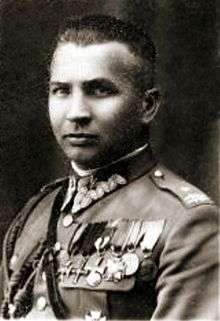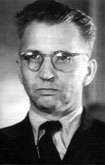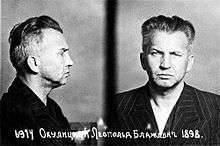Leopold Okulicki
| Leopold Okulicki | |
|---|---|
 Okulicki in the Second Republic | |
| Nickname(s) | Kobra, Niedźwiadek |
| Born |
November 1898 Bratucice |
| Died |
24 December 1946 Butyrka prison |
| Awards |
(4 times) |
General Leopold Okulicki (noms de guerre Kobra, Niedźwiadek; 1898 – 1946) was a General of the Polish Army and the last commander of the anti-German underground Home Army during World War II. He was murdered after the war by the Soviet NKVD.
Life

Okulicki was born in November 1898 in Bratucice, Bochnia County in the Austrian section of partitioned Poland ("Galicia"). His exact date of birth is unknown as the birth record was not preserved in Polish archives and Okulicki himself used two dates: 11 November and 13 November. In 1910 he joined a local gymnasium, and after 1913 he was also an active member of the Związek Strzelecki. The following year, at the age of 16, after finishing basic military training, Okulicki passed his NCO exams. After the outbreak of World War I, in October 1915, he left school and volunteered for the Polish Legions, where he served with distinction in the 3rd Legions Infantry Regiment.
He remained in the Polish Army and fought in various units both during the Great War and the following Polish-Bolshevik War (1919–1921), decorated with the highest Polish military Order of Virtuti Militari.[1] In the interwar period he remained in the army and in 1925 graduated from the prestigious Warsaw Military Academy. Afterwards Okulicki took a post in Grodno local corps headquarters. Until the late 1930s he taught at the Infantry Training Centre in Rembertów, and became commanding officer of Polish 13th Infantry Division.[1]
Nazi occupation
In 1939 he was made commander of one of the departments of the Polish Commander-in-Chief's Headquarters. After Edward Rydz-Śmigły evacuated his staff from Warsaw, Okulicki remained in the Polish capital and served in various posts during the Siege of Warsaw. After the capitulation of the Polish troops defending the capital, Okulicki evaded capture by the Germans and joined Służba Zwycięstwu Polski, one of the first underground resistance organizations formed in Nazi- and Soviet-occupied Poland. In January 1940 he moved to Łódź, where he assumed the post of commander of the local area of that organization. After a brief stint at Headquarters, he was transferred to Soviet-occupied Lwów and became head of that area.[1]
Soviet period

Arrested by the NKVD in January 1941, he was imprisoned and tortured in various Soviet prisons. Released after the Sikorski-Mayski Agreement of 1941, he joined the Polish Army re-created in the USSR, where he assumed the post of the chief of staff. After a brief period as the commanding officer of the Polish 7th Infantry Division he was moved to London for training in the Cichociemni training camp and then transported to occupied Poland. In July 1944, during Operation Tempest, he became the commander of the 2nd Echelon of the Home Army. General Bór-Komorowski, predicting his arrest by the Soviets after the Warsaw Uprising named him his deputy and successor. Okulicki fought in the Uprising, among other posts as the chief of staff of the Home Army. After the capitulation of the Uprising, he managed to evade being captured by the Germans and moved to Kraków, from where he started to reorganize the Home Army. On 3 October 1944 he became the commander of the entire organization. After the Soviet take-over of Poland, on 19 January 1945, he ordered the disbandment of the Home Army, fearing that future existence of an allied force in Poland would only lead to more people being murdered or arrested by the Soviets. Following an NKVD provocation, he was arrested and imprisoned in Moscow.[1] According to him, “In comparison with the NKVD, the Gestapo methods are child's play.”[2] Sentenced to 10 years in the staged Trial of the Sixteen, he was murdered on 24 December 1946 in Butyrka prison. His body was burned and the ashes disposed at the New Donskoy Cemetery, Moscow, where one of his cenotaphs has been later constructed. The other one exists in Powązki Military Cemetery, Warsaw.
| Part of a series on the |
Underground State |
|---|
 |
|
Authorities |
|
Political organizations |
|
Military organizations |
|
Related topics |
Decorations
- Order of the White Eagle, posthumously on 11 November 1995 [3]
- Order Virtuti Militari Golden Cross
- Order Virtuti Militari Silver Cross
- Cross of Independence
- Cross of Valour, 4 times
- Cross of Merit with Swords Golden Cross
- Legion of Merit, posthumously (USA)
References
- 1 2 3 4 Prof. Jerzy R. Krzyzanowski. "Gen. Leopold Okulicki: the Last C-i-C of the Home Army". Warsaw Uprising 1944. Retrieved 2 November 2016.
- ↑ www.doomedsoldiers.com
- ↑ Monitor Polski: Order of the White Eagle.
External links
| Military offices | ||
|---|---|---|
| Preceded by Tadeusz Bór-Komorowski |
Commander of the Home Army 1944–1945 |
Succeeded by None - AK dissolved |